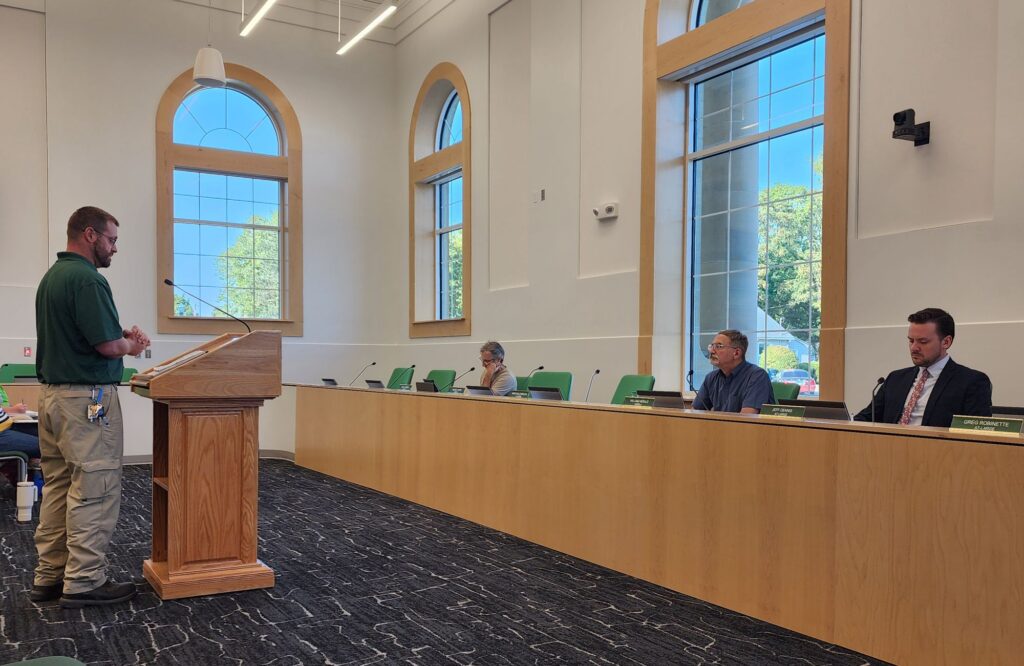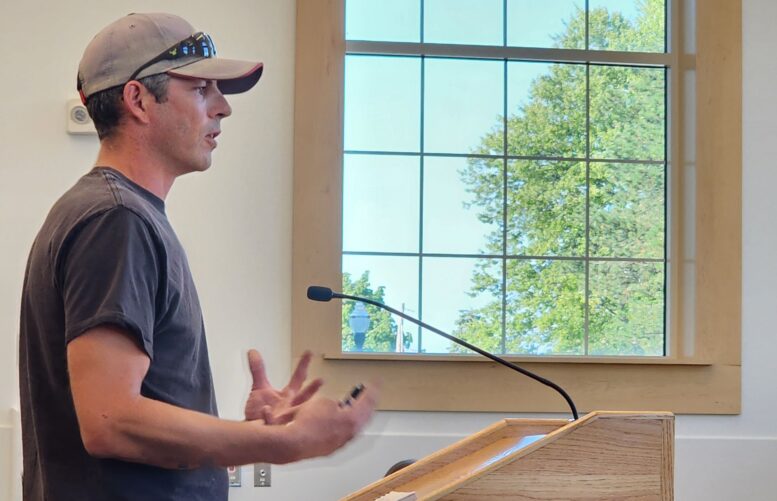By JAN McLAUGHLIN
BG Independent News
After listening to three wildlife experts, a Bowling Green City Council committee agreed Monday evening to put any further animal control efforts into hibernation for now.
The pause is intended to give the city’s wildlife feeding ordinance and education efforts time to work before implementing other actions
But to a few city residents, that pause is just more time for varmints like skunks, possums and raccoons to multiply.
“You all know the animals are just going to reproduce and we’ll have twice as many,” Lora Finch, who lives in the Village subdivision, said as she left the meeting.
Another resident of the Village area, Dick Schroeder, said the decision to delay further action makes as much sense as asking the wildlife to move out and return in two years after city residents are better educated.
But three wildlife experts, invited to the meeting by council member Bill Herald, all agreed that the city should wait to see if the wildlife feeding ordinance adopted in June will create the desired effect.
And the council committee agreed that the city must do more to enforce that ordinance.
The ordinance was adopted after city residents voiced concerns about the growing number of deer and brazen wild turkeys in Bowling Green. But some residents don’t think the ordinance goes far enough – and they want the city to hire an animal control officer.

However, Chris Coakley, of Lucas County Health Department, said the city should be focusing on animal prevention rather than animal control. That means making sure people aren’t knowingly or otherwise feeding wildlife.
“As long as those food sources exist,” animals like raccoons, possums and skunks will also exist there, Coakley said.
In Toledo, anyone found to leave food out for animals other than birds can be cited for creating a public nuisance – a misdemeanor with a possible six-month sentence and $1,000 fine.
While that may sound harsh, Coakley said the issue is serious.
“It would not take very long for 10 rats to become 10,000 rats,” he said.
Coakley described the difference between an animal control officer, who traps, manages and relocates wildlife, and an animal enforcement officer, who looks for “extravagant acts of animal feeding,” writes violation notices, and follows up with criminal enforcement if the notices are ignored.
“I do think it’s a little silly to spend all this money on an animal control officer,” when the focus should be on enforcing the ordinance now in place, Coakley said.
Jason Dunn, a licensed certified nuisance wildlife operator in the Bowling Green area, agreed that wildlife goes where the food is. So people need to remove that source – bring cat food in at night and make sure critters can’t get under dog kennel fences.
“If they can’t find the food, they have to go,” Dunn said.
The same can be said for water – especially now when many water sources are dried up. Right now, animals are looking under decks, or anywhere they can find dew, he added.
And they need habitat – tall grass, brush piles, a lawnmower shed. If those are mowed, picked up, and tightened up, wildlife will go elsewhere. “They are animals of opportunity,” Dunn said.

Justin Harrington, assistant wildlife management supervisor with ODNR, said education is key, and complimented the city for its website with helpful tips for residents. Prevention can be as simple as moving pet bowls inside, spraying for grubs (which are delicacies for skunks), and cleaning up the yard.
Rather than adding more rules now, Harrington suggested the city give its new wildlife feeding ordinance a couple seasons to see if it will have a positive result.
As for larger wildlife, council members asked Harrington how to handle overpopulation of deer. Deer respond well to harassment, he said, but added that once deer become habituated to an area it can be hard to get them to leave. In response to a question about “urban hunting” of deer, Harrington said hunters who meet qualifications enter a drawing to be part of it, and strict details are given as to where and when it can occur. Oftentimes, archery is used.
The council committee – made up of Bill Herald, Jeff Dennis and Joel O’Dorisio – then heard from city residents.
Schroeder agreed that prevention sounds great – but it’s too late for that since the animals are already in his neighborhood, raiding his garden. If a human ripped up his garden and stole his produce, Schroeder said police would respond.
“I don’t think it should be any different if it’s an animal,” he said.
Finch said she has taken all the preventive steps recommended by the experts.
“We’ve got the grub control. We don’t have a sloppy lawn,” no deck and no out-buildings, she said. Yet skunks frequently visit their yard.
“It’s ruining our way of life,” she said. “We need an animal control officer. We need someone to call.”
Debbie Thompson, of Chauncey Lane, said she prefers the focus on education. She noted the number of people who feed wildlife and the number of places with unkept yards that attract animals.
“People need to be educated,” Thompson said.
O’Dorisio said the feeding ordinance and education push should result in changes. But he also suggested a possible next step.
“”I like the idea of a nuisance control officer,” rather than an animal control officer, he said.
Dennis also liked the idea of using civil code enforcement for wildlife, zoning issues and other nuisances. Such an officer could look for “a couch in the front lawn or cat food on the back porch,” he said.
Herald pointed out that some city residents were vocal in their protest of the feeding ordinance. “Some people were pretty headstrong about continuing to do that,” he said.
The committee agreed that the city needs to enforce the ordinances on wildlife, rentals and zoning.
“The enforcement of those ordinances seems to be the chokepoints,” O’Dorisio said.





